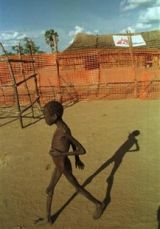Sudanese refugees face malnutrition in Ethiopia
ADDIS ABABA, Ethiopia, June 21, 2005 (PANA) — Critical malnutrition
levels have been found in Bonga and Fugnido camps in
western Ethiopia’s Gambella Region where an estimated
50,000 Sudanese refugees are living.

|
|
A starving Sudanese boy roams a compound run by Doctors Without Borders in Ajiep, Sudan within famine-torn Bahr el Ghazal province in south Sudan, in this July 25, 1998. (AP). |
According to a nutritional survey by the World Food
Programme (WFP), UNHCR and Administration for Refugee
and Returnee Affairs (ARRA) there was a Global Acute
Malnutrition (GAM) of over 20% and Severe Acute
Malnutrition (SAM) of 7% in one part of Fugnido
camp.
The highest malnutrition levels were found in the
newly established section of the camp at Anuak, says
the report released here Tuesday.
A combination of factors have led to this severe
situation.
These include delayed delivery of food due to
transport problems, insecurity both inside and outside
Fugnido camp, and a lack of basic health and safe
water services.
In Bonga camp, food deliveries have also been delayed
and crops have not been planted due to restrictions in
movement outside the camp.
Meanwhile, WFP reported that it was urgently
transporting blended food to the camps in order to
start blanket supplementary feeding for all children
under five, and to continue the supplementary feeding
programme for pregnant and nursing women.
The agency was also pre-positioning food stocks for
three months ahead of the upcoming long rainy season.
UNHCR is providing water through tankering until basic
services were fully implemented in the Anuak section
of Fugnido camp.
However, WFP said confirmed contributions for blended food
would only cover needs for the next two months. New
contributions were needed to avert a further deterioration
of the nutritional status in the refugee communities, it added.
